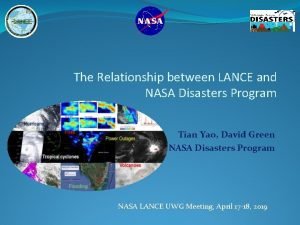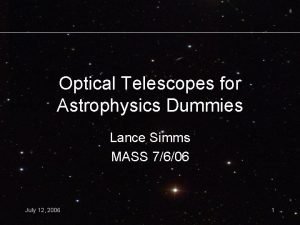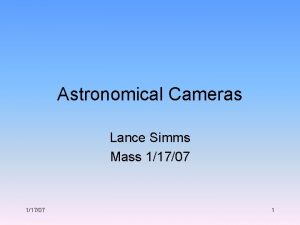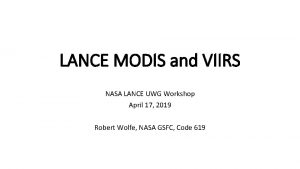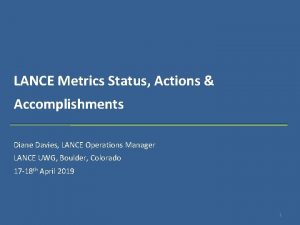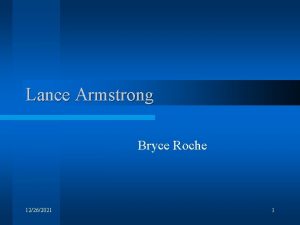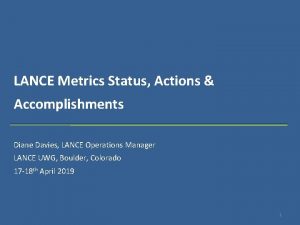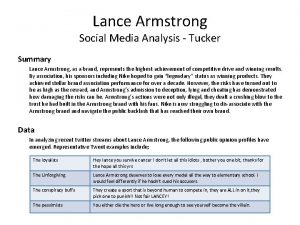Exploring Astronomy SPLASH Lance Simms Josh Chan Michael























- Slides: 23

Exploring Astronomy SPLASH Lance Simms, Josh Chan, Michael Kran, Jeff Lou, Stanford Tran 4/5/09

What you will learn • • Earth Coordinates The Celestial Sphere and Sky Coordinates The North Star Measuring distances on the sky The Motion of Objects in the sky The Zodiac, Equionoxes, and Solstices Using the moon as a clock Basic Astronomical Objects

A Reminder About Earth • The earth is almost a sphere • We locate points on the sphere with 3 coordinates – Latitude (90º S -- 90º N) – Longitude (180º W -- 180º E) – Altitude (m above/below sea level) • These are referred to as Terrestrial Coordinates *images taken from http: //nationalatlas. gov/articles/mapping/a_latlong. html

Reference Points/Lines on Earth North Pole • �� Latitude – – – North Pole (+90º or 90º N) South Pole (-90º or 90º S) Equator (0º N/S) Tropic of Capricorn (23º 26’ 22” S) Tropic of Cancer (23º 26’ 22” N) • Longitude –Prime Meridian* (0º E/W) –International Dateline (180º E/W) South Pole Int. Dateline *Prime Meridian passes through Royal Greenwich Observatory in London Prime Meridian *images taken from http: //nationalatlas. gov/articles/mapping/a_latlong. html

Main Units in Astronomy A Circle is 360 Degrees A Degree is 60 Arcminutes An Arcminute is 60 Arcseconds Thus, a Circle has 90º 90º 360º x 60'' = 1, 296, 000'' 1 º 1' On earth’s surface (at the equator): 1º ≈ 69 miles 1’ ≈ 1. 15 miles 1'’ ≈ 100 feet SYMBOLS º = Degree ' = Arcminute '' = Arc. Second

Our Grid is Tilted and Rotates! • • • The Earth’s Axis (imaginary line through north and south poles) is tilted by ~ 23º with respect to its axis of revolution about the sun Tilt gives rise to seasons (earth is closer to sun in winter than in summer!) Revolution gives rise to a changing night sky Summer Night Sky Summer Spring Winter Night Sky Winter Fall - Axis of revolution 1 revolution = 365 days - Axis of rotation 1 rotation = 1 day

Earth Rotation = Sky Rotation Polaris - The North Star Circumpolar Star - “Around the Pole” star - Does not set below horizon in the sky at a particular latitude Noncircumpolar Star - Rises and sets at some time during the day or night • • The stars in our sky are actually “fixed” They appear to move because of the earth’s rotation - Earth rotates east - Stars appear to move west • • They trace out circles around the axis of rotation This image was taken at Mauna Kea by leaving the shutter open for a few hours; star trail pictures are easy to do for anybody with a nice camera! *image taken from http: //apod. nasa. gov/apod/ap 051220. html Horizon - where the sky meets the earth

Finding Polaris: the North Star • • • Polaris is nature’s compass Draw a line straight from Polaris to the horizon with your finger and you will be pointing toward geographic north* To find Polaris 1) Start at the two end stars of the big dipper ladle 1. Merak and 2. Dubhe 2) Multiply their distance by 4 and follow the line from 1 to 2 that distance until you hit 3 Polaris 3 2 1 Note: - Geographic North actually deviates slightly from Magnetic North, the direction of the north magnetic pole of the earth. Don’t be confused if your compass doesn’t point exactly towards the north star. - The discrepancy varies with latitude. *Only works if you can see the big dipper Image taken from http: //en. wikibooks. org/wiki/Adventist_Youth_Honors_Answer_Book/Recreation/Backpacking

Polaris: The Poor Man’s GPS • Polaris can be used to determine your latitude! • Angle from Polaris to horizon is your latitude Image taken from http: //lasp. colorado. edu/~bagenal/1010/images/latitude. jpg

Measuring Angles on the Sky • We can measure angles on the sky using our hands and fingers . 5º Moon is about. 5º in angular diameter Image taken from http: //www. astro. virginia. edu/class/oconnell/astr 121/im/fingerangles. jpg

Position of Polaris For an observer located at some latitude and longitude • Polaris stays in same spot throughout the night • We say it has the same Altitude and Azimuth throughout the night • We can refer to all stars and objects with two angles (Altitude, Azimuth) • These are Local Coordinates • In Palo Alto, Polaris stays at (+37. 43, 0) 90º = Zenith Altitude Azimuth 0º = Horizon Comparison to Terrestrial Coordinates Latitude Altitude (0º to 90º ; - is below horizon) Longitude Azimuth (0º is N, CW to 180ºS)

Limitations of Local Coordinates • For an observer, all stars and objects in sky besides North and South Pole stars have Altitude and Azimuth that are constantly changing • Two people at different spots on earth will disagree about Alt. , Az. coordinates even if they are looking at the same object at the same time Solution: Use a coordinate system that is glued to the “fixed” stars rather than a spot on earth

The Celestial Sphere • • The “Celestial Sphere” is an ancient concept dating back to the time when we thought the earth was the center of universe It is a “gigantic” sphere glued to the stars Stars appear to rotate because sphere is rotating Sun, Planets, Comets, Asteroids all move on surface of sphere Images taken from http: //zebu. uoregon. edu/~imamura/121/images/sphere. gif

Coordinates on the Sphere • Just like Terrestrial Coordinates on earth, we define Celestial Coordinates for the Celestial Sphere • Stars and other things outside our solar system have a particular Right Ascension and Declination or RA and DEC (almost constant) • Earth’s Equator, North Pole, and South Pole line up with the Equator and North Pole, and South Pole, of the Celestial Sphere Coordinate System North/South East/West Terrestrial Latitude Longitude Celestial Declination Right Ascension Ecliptic - extremely important line along which planets and the sun appear to move as viewed from earth Image taken from http: //www. onr. navy. mil/focus/spacesciences/images/observingsky/celestialsphere. jpg

More about Celestial Coordinates Right Ascension (RA or ) - Sometimes Referred to in Hours - 1 Hour = 15º - 0 - 360º or 0 - 24 Hours (h) - Why Hours? Because the sky rotates 360º in 24 hours of time. So in 1 hour of time, sky appears to rotate by 15º. Declination (DEC or ) - 0º is Celestial Equator - +90º is Celestial North Pole - -90º is Celestial South Pole Note: I will not cover how to convert between local and celestial coordinates. You can either do the trigonometry or use an online calculator.

Right Ascension and the Zodiac The Ecliptic is: The apparent path of the sun across the heavens The Zodiac is: The ecliptic divided into 12 segments - Each segment subtends 30º or 2 h of RA - Your zodiac “sign” is the constellation that the sun was in when you were born 12 h RA - Libra the Scales 30º 0 h RA - Aries the Ram *Note: Due to precession of Earth’s axis, the position of the sun in the zodiac constellations is actually shifting Image taken from http: //www. astrologyclub. org/articles/ecliptic 2. gif

The Zodiac and Seasons • • • The plane of the Ecliptic is tilted by about 23º with respect to the Celestial Equator They intersect at two points 1. Vernal Equinox (Pisces 0 h RA) 2. Autumnal Equinox (Virgo 12 h RA) The Sun has its maximum declination at 3. Summer Solstice (Gemini 6 h RA) The Sun has its minimum declination at 4. Winter Solstice (Sagittarius 18 h RA) Below is a table showing the position of the sun at each of the 4 points 4 1 3 2 *Image taken from http: //www. astro. uiuc. edu/~kaler/celsph. html Spring Equinox (March 21) Summer Solstice (June 21) Autumn Equinox (Sept. 21) Winter Solstice (Dec. 21) RA 0 h 6 h 12 h 18 h DEC 0º +23º 27' 0º -23º 27' Very useful to know since we cannot see constellations when they’re behind the sun!!

How it looks on the Sky Meridian

Getting to Know the Moon • Phases of Moon Mnemonic: Waxes from West - Wanes from East • Handedness depends on Hemisphere (North / South) • Moon rises about 40 minutes later each night • Terminator - Great name for where shadow meets light on moon Left Right Left *Image taken from Len Smith at Sword. Bearer. orgç

Moon As A Clock: Step 1 • Because Illumination of moon tells us Earth-Sun orientation, we can use it as a clock!! * 1) Find the terminator 2) Match it to an hour between 6 PM-6 AM according to the diagram on the right 3) Is it lit from West or East? WEST - Setting time EAST - Rising time * Yeah…. At night, this only works when the moon is visible which is only like half of the night time per month *Image taken from Len Smith at Sword. Bearer. orgç

Moon as a Clock Step 2 • Based upon the rise/set time, use the location of the moon in the sky to guess the hour – Pretend moon moves at 15°/hour from east to west Quiz: What time is it? The moon rose at ~5: 00 am ~10° from east -> 5: 40 am *Image staken from Len Smith at Sword. Bearer. orgç The moon will set at 3: 00 am ~90° from west -> 9: 00 pm

Atmospheric Effects • Air in our atmosphere causes the light from stars to “bounce” around • The lower in the sky something is, the more it bounces – More air between us and the place where the star’s light entered our atmosphere • The effect is similar to the way wavy patterns appear behind a jet engine or above concrete on a hot summer day • Keep this in mind when looking through a telescope – In the olden days, astronomers spent hours and hours waiting for calm periods in the atmosphere Movie showing a star while being focused through a telescope. Atmosphere makes the star dance.

To Learn More • Cosmos: A Personal Voyage series by Carl Sagan (available as DVD set) – Absolutely brilliant 12 episode series on everything from Copernicus to black holes to extraterrestrial life • The Observer’s Sky Atlas by Eric Karkoschka – A map of the night sky with some great introduction material about stars • Nightwatch: A Practical Guide to Viewing the Universe by Terence Dickenson and others – Very nicely written and easy to tackle
 Lance simms
Lance simms Local hour angle
Local hour angle Learning astronomy by doing astronomy activity 1 answers
Learning astronomy by doing astronomy activity 1 answers Learning astronomy by doing astronomy activity 1 answers
Learning astronomy by doing astronomy activity 1 answers Learning astronomy by doing astronomy activity 1 answers
Learning astronomy by doing astronomy activity 1 answers Bé thì chăn nghé chăn trâu
Bé thì chăn nghé chăn trâu Lauren simms
Lauren simms Sffas 50
Sffas 50 Lance nave
Lance nave Kelsey kidd
Kelsey kidd Wait for it the mongols
Wait for it the mongols Lance hammond
Lance hammond Lance antincendio
Lance antincendio Lance wells
Lance wells Roque xeque mate
Roque xeque mate Lance growth 1031
Lance growth 1031 Rampa
Rampa Lance brothers enterprises acquired
Lance brothers enterprises acquired Sts crane simulator
Sts crane simulator Lance compiler
Lance compiler Fecalith
Fecalith Lance nasa
Lance nasa Lance a fut tronconique
Lance a fut tronconique Lance fried
Lance fried





















